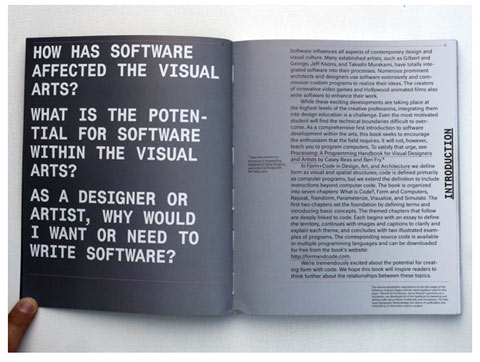Aye, Form + Code is the new book for Casey Reas, Chandler McWilliams + LUST, which carves it’s academic credibility by having not only one, but two, subtitles:
a) In Design, Art, And Architecture
b) A Guide to Computational Aesthetics.
Nonetheless, if you’re remotely inclined to create with computers – it’s a great and encouraging, provocative read.
Software Aided Innovation
A stoner sitting on the edge of a rooftop tells you: “Y’know what? I really looooove software.” Grinning insights follow, some of which make sense, some which don’t. Software can permeate so much of our interactions today, our existence, that it’s easy to take for granted that effectively we live with swarms of robots in our midst. Robots that automatically pay our bills, robots that share communications with friends, robots that search for us, robots that play back media for us. When it comes to robots that might aid us in the creative disciplines though ( be it art, music, design, architecture, etc ), in what ways are we limited by their design? In other words, in a question that’s at the heart of the Form + Code book, and aimed directly at creatives who use computers – to what extent do we wish to be limited by the constraints of any particular software system?

Defining Form as visual and spatial structures and Code as computer programs and non-computer instructions ( eg IKEA furniture building instructions, or instructions for knitting a scarf ), the book wanders through a history of computer aided creative work, and attempts to meaningfully categorise the different ways code can be useful. The book is definitely aimed at non-coders, an attempt to encourage more creatives to explore the options they have available for customising and creating code to make their work. For someone only recently dipping toes into the visual programming / patch based environment of Quartz Composer, the book provides a nice framework for thinking about image manipulation, and removes some of the ( … well, let’s just say it.. ) fear surrounding abstract coding.

Some general core coding principles are presented simply, which is followed by examining how the computer relates to form – through defining co-ordinates, shapes, and colour, and then the extra layers of light, printing and fabrication bringing the form to life. It’s an approach which works well, demystifying the possibilities, and illustrating them well with a range of provocative contemporary and historically important examples ( in graphic design, typography, data mapping, digital fabrication, interactive media etc ).

Naturally there’s code to play with ( via the companion site ), and the aims behind the book are reinforced when it is understood co-author Casey Reas has also co-authored (with Ben Fry) the programming language Processing ( free for mac, linux, PC), which is described as ” a software sketchbook.. an open source programming language and environment for people who want to create images, animations, and interactions”.
( Out now through Princeton Architectural Press )
